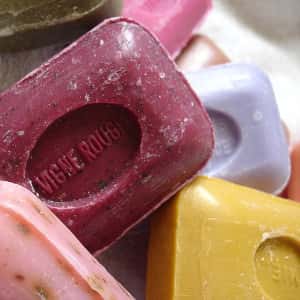
by Derek H. Page
There is far too much anecdotal evidence to dispute the fact that soap at the bottom of the bed can relieve nocturnal leg cramps. But contributors to this column have been pleading for a scientific explanation ever since the subject was first raised, nearly twenty years ago. Even after years of discussion there is no consensus on the mechanism. How does the soap ward off the initiation of a cramp? For the leg to be influenced by a signal initiated by the soap, something physical must link from soap to leg.
A crucial clue comes from the work of Professor Ough (1). He found that soap contains a natural scent molecule that has antispasmodic properties. When a transdermal patch was applied using soap as the active ingredient, the severity of menstrual cramps could be diminished. However, Ough does not state precisely how this result can explain why cramps can be alleviated in a leg remote from the active source. How can the scent molecule be transmitted from its place in the bar to the leg muscle?
My colleague and I address this point (2,3). We also suggest that a scent molecule is responsible (whether it be the added fragrance or a natural fragrance). Being volatile, it evaporates from the surface of the bar and deposits on the leg. The molecule is small enough to pass through the skin as in the widely accepted transdermal patch technology. Being vasodilatory, the molecule relaxes the smooth muscles in the leg, increases the local blood supply and thus soothes the cramp. This hypothesis fits all the known evidence. It explains why after some weeks the soap becomes inactive. As the bar ages it dries out and its surface becomes harder and more resistant to the passage of scent molecules. The bar can be rejuvenated by scraping it, thus exposing newer and moister surfaces.
However, the anecdotal record allows for an alternative hypothesis as follows. The active agent, as in the previous hypothesis, is the vasodilating scent molecule. In this hypothesis, however, it is transmitted to the leg by the simple but uncertain process of accidental touch. Soap is soft, and any contact between the soap and the leg is bound to leave some soap behind. In addition soap will be transferred to the sheets which will in turn transfer back to the legs. Movement of the legs in the night may be sufficient to transfer soap to the legs which relieves cramps as described earlier. The anecdotal evidence supports this mechanism. There are cases of successful relief reported in which soaps were rubbed against the calf muscles. Most significantly, the effect of aging of the soap bar, which supported so well the other hypothesis, fits this one also. As the bar of soap ages, its surface becomes firmer and more resistant to transfer by abrasion.
So there we are. We have two hypotheses, neither of which can be disproved by existing data. There is however a very simple experiment that could allow us to determine whether transfer occurs in the vapour phase or only by direct contact. Any reader who has had severe leg cramps and who has been completely cured by placing soap at the foot of the bed can do it.
Use a bed in a spare room that hasn’t been slept in for a couple of weeks and has fresh sheets. Place the soap in a plastic container that prohibits physical contact between the soap and the leg. It must, however, permit easy passage of the scent vapor. Ensure the container is not contaminated on the outside with remnants of soap. Place in the container a couple of bars of soap that you know from experience work. Put the container at the foot of the bed between the sheets and leave it there for at least a few hours to equilibrate. Check that you can smell the scent by putting your head under the covers. Have a shower (without soap!) and get into bed. If you have a cramp in the night you can conclude that vapour phase transfer of the scent molecule is not sufficient to protect the leg from cramps. If you have no cramp the vapor phase transfer mechanism is confirmed.
1.Ough, Y.D., Journal of Alternative and Complementary Medicine, July 2008,14(6) 618
2. Page, D.H. and Smailes, H., Peoplespharmacy.com, July 22, 2012
3. Page, D.H., Peoplespharmacy.com July 26, 2012
This hypothesis was submitted by guest blogger Derek H. Page. We invite you to share your experience below, particularly if you are inspired to carry out his suggested experiment. Should you wish to read some startling “soap stories” here is a link.

